Matador Network's Blog, page 497
April 11, 2022
8 Mistakes To Avoid When Road Tripping With Kids

We have road-tripped over 40,000 miles, through the past 7 years with our kids. As a matter of fact, the very first road trip we did with a baby was when our daughter was only 7 weeks old. We drove the 15 hours from Virginia to Florida. After we welcomed our second child, we hit the road even quicker and took a 15-hour road trip when he was only 4 weeks old. Since then, we have crisscrossed the United States several times with our kids and learned many lessons along the way.
Throughout these road trips, we have figured out what works best when on a road trip with kids and what does not. This guide will walk you through 10 avoidable mistakes when road tripping with kids and hopefully help you avoid them!
The GPS is wrongIt’s going to take longer! Taking a road trip with a baby or toddler means adding in extra stops for feedings, diaper changes, and to get the wiggles out. If your GPS says it will take 9 hours, plan for at least 11. There’s no such thing as a straight shot when it comes to kids in a car.
Remember time zone changesWhen road tripping with kids in the United States, it’s easy to forget you may be crossing 1 or 2 time zones in a day. For example, most people wouldn’t know that the state of Florida has two time zones! So, be sure to check prior to departure, if any place you’re crossing into will be crossing into a new time zone.
Give yourself a breakNot doing so is a typical rookie mistake when road tripping with kids. There is a widely accepted “2-hour rule” that says to take a baby out of the car seat for a break every 2-3 hours to prevent them from getting restless. Choosing stops with a playground or play place to let the toddlers and kids get some energy out is always the best. Another idea is to choose a stop, such as a unique roadside attraction, that is engaging for the entire family. When on a road trip with a baby, you don’t need to plan as much because they just want comfort and snuggles.
Stopping? Make sure everyone uses the bathroomDon’t ever listen to, “I don’t have to go.” It’s a trap! Not making sure every single person used the bathroom or had a fresh diaper change–another rookie mistake. If your child tells you they don’t have to go, encourage them to try and wait until they do. You’d hate to be back on the road and nowhere near a rest stop for them to go once you’ve already left one.
Take pit stops when kids are awakeI know this cannot always be accommodated but try your best. When a child falls asleep in the car, this is the best time to really get the miles behind you, uninterrupted. This is also the calmest and safest time to be driving since there are fewer distractions inside the car. So, when you are planning to stop, make sure it’s when the kids are wide awake and alert.
Download entertainment in advanceBefore every single road trip we take, we pull out the iPads and download as many movies as we can. Streaming services like Netflix, Amazon Prime, Hulu, and Disney+ all allow you to download certain movies and shows that can be accessed without the internet. You can also download educational games that can be accessed without the internet! Whether it’s through a phone or tablet, the options are endless, including being able to download things if you have a YouTube Premium account.
Don’t forget the toysReal estate in the car on a road trip is precious, but keeping little ones entertained for hours in the car is vital. We usually pack a small basket of quiet toys in the car. For babies, we hand the toys back one at a time so they aren’t overstimulated. For toddlers and little kids, it’s a great idea to place the basket of toys where they can reach it from their seats. This allows them to be in control and choose what they want to play with. bring some of their favorites, in addition to adding one or two new toys they can keep themselves entertained by.
Bring lots of snacksSaving the best for last, I must passionately reiterate, DON’T FORGET THE SNACKS! Snacks will keep anyone at any age entertained in the car. However, if you are on a road trip with a toddler, snacks are paramount. Head to your favorite Walmart, Target, Costco, etc., and grab as much as you can. It’s better to have more than less and a variety depending on how long your trip is going to be. Snacks save road-tripping parents’ sanity…Thank me later. 
Splitting the bill around the world

Everyone has their own idea about the most polite way to split the bill at a restaurant. Some people prefer their own itemized check, so they only pay for what they ate and drank. Other people are more relaxed about the whole affair, splitting the bill evenly rather than haggle over glasses of wine and sides of French fries. There are others still who reject the concept of going Dutch, entirely, insisting that they cover the entire bill themselves – as long as their friends get the check next time, of course. In fact, in many cultures it’s actually customary – expected even – for an argument to erupt over who gets the honor of paying the dinner bill. Restaurant etiquette in a new country can be a tough nut to crack, in other words.
You’re probably already familiar with how people in your part of the world prefer to split the bill. But when you’re traveling somewhere you’ve never been before, there’s no doubt that if the customs are different than what you’re used to, splitting the bill can turn into an awkward ordeal. Some people might throw down their credit cards, while all others have is cash, and then it might turn out that the restaurants won’t even offer separate checks. That’s why it’s best to come to any new place you might be visiting with the necessary information on local etiquette when it comes to paying the dinner bill. Same thing goes for tipping – most countries have their very own customs when it comes to leaving gratuity behind, too. That way, you never get caught looking foolish when it’s time to close your tab. Here’s proper etiquette for splitting the bill from 21 countries around the world.
AUSTRALIA: Splitting the bill is common practice in Australia. Friends often are happy to split the bill evenly, but it’s also acceptable to only pay for what you ate and drank.
CANADA: Some restaurants in Canada will create separate checks, depending on how many people are in your party, otherwise it’s expected that
CHINA: In China splitting the bill is known as ‘AA,’ but it’s not a widespread practice. According to CNN, it’s “splitting the bill is a relatively new idea to most Chinese.” Mostly, you’ll find younger people willing to split the bill at dinner, but for older folks, it’s much less common. Friendly arguments break out over who will cover the bill – it’s considered honorable, generous, and as one blogger put it, Chinese people “insist on picking up the tab to keep ‘mian zi,’ or face.”
FRANCE: Not only is it not the norm in France to split the bill, it’s considered impolite. Friends like to take turns treating each other to a meal, and if you’re the one that suggested the meal or you’re playing host, expect to be the one to pay. In more casual settings, sometimes going Dutch is okay, but the check will probably be split evenly.
GERMANY: Waiters will often ask “together or separate,” at restaurants in Germany. If you opt to pay separately, the waiter will come with checks for each person in the party. That way, you don’t have to worry about haggling over who ate what at dinner.
GREECE: If you ask to split the bill while out to dinner in Greece, you risk looking rude. The best way to approach paying for dinner is to offer to cover the check and rest assured that your friends will most likely return the favor at the next meal.
ICELAND: You don’t have to worry about awkwardness over splitting in Iceland – it’s a completely acceptable practice.
IRAN: In Iran, friends will often argue who will cover the restaurant bill, so don’t expect to encounter many people who will want to split the bill.
IRELAND: Ireland is popular for its bill one-upmanship. Anne Merrit, who has family there, says: “There’s lots of arguing and grabbing that toes the line between good-natured and ruthless. It’s really awkward to witness as an outsider. My grandfather goes as far as slipping the waiter his credit card before the meal has even begun in order to nip an argument in the bud.”
ISRAEL: Travel forums give conflicting advice, but the cultural norm in general seems to pay with cash if you can, even though credit cards are often acceptable (though probably not preferred). Splitting the bill is acceptable as well, but it might be best to ask the restaurant if they allow this payment method beforehand.
ITALY: In Italy, cash is also the preferred method of payment, and most restaurants will find it inconvenient to split the bill among multiple people, especially if you’re trying to pay by card. If you’re with a group, the best thing to do is ask if they’d be willing to split the bill before you find a table. More complicated ways of splitting the bill, wherein some people pay with cash while others put down their cards, probably won’t be allowed.
JAPAN: In Japan, splitting the restaurant bill is known as warikan. Usually, the bill will be split evenly, rather than each person paying only for what they ate and drank. It’s good practice to let the restaurant know beforehand if you intend to split the bill.
LEBANON: Social norms in Lebanon dictate that you will never split a dinner bill, even on a casual occasion out with friends. Arguments tend to break out over the restaurant bill, with everyone at the table insisting that they’d be honored to pay for dinner. The practice is so common that a Lebanese television station even made a sketch parodying two men getting in a literal fist fight over the check.
MEXICO: Splitting the bill is uncommon in Mexico. Whoever invites friends or family out to a meal is the one to pay the bill.
NORWAY: In Norway it is considered polite to allow your dinner companions to split the bill with you, rather than insisting too vehemently that one person cover the entire cost.
PHILIPPINES: Shorthand for the splitting the bill in the Philippines is “KKB” or “kaniya-kaniyang bayad,” meaning “each pays their own.” It’s totally acceptable practice among groups of friends and even on first dates.
PORTUGAL: You’re likely to witness a friendly kerfuffle over who will pick up the check. If you invited your friends or family out to dinner though, you’ll probably be expected to pay for the meal.
SCOTLAND: Splitting the bill is common practice in Scotland, but it’s even more polite to let the restaurant know you plan on paying separately before you order. Otherwise, it’s completely acceptable to pay the check with a few different cards or cash.
SOUTH AFRICA: At casual dinners among friends, splitting the bill is the norm.
SOUTH KOREA: If you’re out to dinner with someone older than you, that person will likely cover the dinner bill. Even during more casual dinners among friends, splitting the bill isn’t the default. Usually, one person will offer to cover the check, while the other diners insist that they will treat whoever paid at the next mean. However, norms are changing, so you might encounter more willingness to split the check.
SPAIN: In Spain, paying the bill largely depends on the region you’re in. It’s not common practice, but you will find that in some parts of the country, splitting the bill is nicknamed, “a la Catalana,” meaning that everyone pays their own way.
SWEDEN: In Sweden, it’s not very likely that couples will split the bill on a date – usually one person covers the entire check. At a group dinner, expect to split the bill, or in some cases, one person will cover the whole check but be asked to be reimbursed on one of the many apps for splitting the bill. Cashless payment is also the norm.
THAILAND: Splitting the bill is common in Thailand, especially among friends, but it’s also regular practice for the host to cover the dinner check for the whole group. In fact, the custom among Thai people is that the oldest person at the table – who is often considered the most financially stable – will pay for the meal. If your host does insist on covering the check, arguing or trying to pay your share would be considered rude.
UNITED KINGDOM: Splitting the bill is common practice at restaurants throughout the United Kingdom. Some people prefer to split the bill evenly to avoid an awkward confrontation over who ate what. But this position is not without controversy: Some Brits, for instance, believe calculating precisely what each person owes is the only way to go, despite any awkwardness this might cause.
UNITED STATES: The bill is usually split evenly, and nickel and diming can even be considered tacky. However, it’s not uncommon to simply pay for what you ordered, but getting separate bills can be considered a pain.
VIETNAM: It’s not customary to split the bill, even among friends. The host, or whoever handled organizing the group dinner, is responsible for paying the bill. However, often friends are expected to repay the favor at the next dinner. Even if you are with a group of friends who agree to split the bill, don’t bother trying to pay only for what you ate – Vietnamese restaurants won’t create separate checks so you’ll end up splitting the bill evenly. 
8 of the Steepest and Most Extreme Highways in North America for Thrill-Seeking Road Trippers

Ah, spring – when snow is melting off mountain peaks and the sun dares to peek out from behind gray winter clouds. For some, it means the start of family vacations and weekends spent hiking or camping. But for others, it’s time to hit the road.
But if you want this year’s scenic road trip to be different from years past, with a change of scenery and certainly no 10-hour drives across endless Kansas plains, explore these roads with the steepest highway grades in the US. These seven roads with the steepest highway grades in the US (plus a bonus drive in Canada) have some insane hairpin turns and will test your brakes (and your nerves), especially since many are winding, two-lane roads.
While federal law requires interstate highways to have a maximum grade of six percent, state highways are a different story. Pennsylvania maintains a highway with a 14.5-degree slope, and California is even steeper, with a highway at a whopping 26-degree grade. Highway grades are pretty easy to understand and expressed in 100-unit increments. For example, a highway with a six-percent grade means it gains (or loses) no more than six feet of elevation for every 100 feet of distance.
This year, for a road trip that won’t put you to sleep, choose one of these roads that put you at the edge of your seat – both to see the beauty outside your window and to brace yourself on the steep downhills. Here are seven of the steepest highway grades in the US that have somehow been allowed to exist, plus one through some of the most beautiful scenery in Canada.
California Route 108
Photo: Sundry Photography/Shutterstock
Starting and ending points: Modesto to BridgeportSteepest section: Sonora PassMax grade: 26 percentIn the 1850s, entrepreneurs built a series of passes through the Sierra Nevada mountain range to help immigrants reach California during the Gold Rush. The narrow routes were first cleared for wagons and later became private toll roads, then state highways. These passes, called the Trans-Sierra roads, cross over some of the country’s most inhospitable terrain. As a result, the roads are winding, narrow, and definitely steep.
There are more than 20 passes throughout the Sierra Nevada, but none as precarious as the Sonora Pass along CA-108. It’s just 90 minutes away from Sacramento, but you’ll know you’re not in the city – the twisting, hairpin turns and slog as you trudge up a mountain road at an incredible 26-percent grade will make it very clear you’re deep into the mountains.
To further underscore the potential danger, know that this highway (along with several other Trans-Sierra roads) closes to the public for the winter. Between roughly November and April, you’ll have to take the long way around. (And, oh, is it long.) And even when the road is open, slick roads and icy conditions still demand well-honed driving skills.
Travelers searching for the utmost beauty on their road trips will want to take a short detour to Stanislaus National Forest. With 78 alpine lakes, towering trees, and plenty of wildlife, nature-lovers will find themselves among some of the nation’s most fascinating natural features without the crowds of Yosemite National Park to the south.
Texas Farm to Market Road (Route 170)
Photo: Moses Rode/Shutterstock
Starting and ending points: Candelaria to Study ButteSteepest section: Area around Big Bend Ranch State ParkMax grade: 15 percentDeep in the southwest corner of Texas, you’ll find this scenic highway that travels along the Rio Grande River. While a select few will recognize the road from the old western movie Contrabando, many will remember the steep, curving climb up what the locals dub “the Big Hill.”
Be careful when roadtripping along this highway. With no easy alternate route to Presidio or Big Bend National Park near the road’s endpoints, travelers have no choice but to drive up and down a 15-percent grade. And it’s reasonably common to have both wildlife and livestock wandering across the roads.
The advice here? Take your time.
As remote as this corner of Texas is (the nearest major city is San Antonio, which is six hours away), road-trippers will find only a spattering of cars along FM 170. Take “the Big Hill” as slowly as needed and enjoy the views from the overlook at the top. You likely won’t have any cell service either, so download a map in advance if you want to stop along the way. Cool nearby detours include the ghost town-turned-artistic hub of Terlingua, Big Bend Ranch State Park itself (not to be confused with Big Bend National Park), and the old movie set from Contrabando, which sits unmarked in a gully along the Rio Grande.
Utah Route 143
Photo: mark higgins/Shutterstock
Starting and ending points: Parowan to PanguitchSteepest section: Area around Brian Head Ski ResortMax grade: 13 percentAvid skiers may know this drive well. If you’re heading up to Brian Head ski resort for a long weekend, you’ll find yourself navigating one of the steepest roads in Utah.
Originally an old pioneer road used to transport logging materials, Utah Route 143 winds its way through the Dixie National Forest. The highway can reach grades of over 13 percent as it ascends to the top of the ski resort. As a result, drivers frequently overheat their brakes, and large trucks will try to avoid the byway altogether to keep them from catching fire. Oh, and of course, having fresh snow and ice on the ground really doesn’t help matters. Neither do the out-of-towners with two-wheel-drive cars and no winter driving skills trying to make their way in late at night on Fridays.
Due to sometimes icy conditions, the Utah Department of Transportation regulates the highway’s usage. Utah’s DOT regularly cleans the road and often requires chains in colder months. Because of their efforts, the most challenging aspect of driving this road is sharing it with the influx of skiers about to hit the slopes. If you go during a storm, make sure you have four-wheel-drive and snow tires or have chains in your trunk (and know how to put them on).
Wyoming US-Route 14
Photo: Jess Kraft/Shutterstock
Starting and ending points: Yellowstone National Park to South Dakota state lineSteepest section: Shell CanyonMax grade: 13.5 percentBefore the interstate system modernized cross-country travel, Americans relied on US highways like Route 66. One such highway, built in 1926, runs from Chicago, Illinois, to Yellowstone National Park in Wyoming. But just a few hours from the park, the road starts to get a little sketchy.
US-14 enters Big Horn National Forest about an hour outside of Buffalo, Wyoming. But the bighorn sheep aren’t the only big thing in the forest. The highway traverses near Black Mountain and Sibley Lake while steadily climbing at an average grade of 10 percent. If you thought that was tough, wait until you start to climb up the 13.5-percent grade breaking point.
Needless to say, RVs face an uphill (or, rather, downhill) battle the entire way, and semis avoid the highway altogether.
The road ascends precariously high at a max elevation of 9,430 feet, and the state of Wyoming shuts it down to the public for the winter. In spring and fall, the obvious place to stop along this scenic drive is Yellowstone National Park, though Devil’s Tower (from Close Encounters of the Third Kind fame) and Cody, a historical western town founded by Buffalo Bill, are just a short drive off the main drag.
Colorado State Highway 149
Photo: Brian Wolski/Shutterstock
Starting and ending points: South Fork to GunnisonSteepest section: Around Slumgullion PassMax grade: 9.5 percentAlso known as the Silver Thread Scenic Byway, CO-149 meanders up through the Rio Grande National Forest to Slumgullion Pass at 11,530 feet above sea level. With dizzying grades as sharp as 9.5 percent, it’s Colorado’s steepest paved road.
The highway cuts through the middle of the national forest and travelers could spot deer, elk, moose, and bighorn sheep in their natural habitats – the fact that it’s one of the steepest highway grades in the US doesn’t bother them one bit. While navigating the highway for rogue wildlife, adventurers may also want to make a stop at Lake San Cristobal, about a three mile detour). It’s the state’s second-largest natural lake at around 9,000 feet.
The byway was built over an old mining road once used to transport ores and supplies to the San Juan Mountains. Even experienced road-trippers will likely find the driving conditions challenging. Drivers who would like to bypass the bypass (get it?), can take Highway 285, which circumvents the national forest in a more leisurely, albeit longer, drive.
Pennsylvania Route 487
Photo: SNEHIT PHOTO
Starting and ending points: Paxinos to DushoreSteepest section: Near Ricketts Glen State ParkMax grade: 14.5 percentTravelers coming from Harrisburg, Pennsylvania, might be able to attest to the difficulties of driving along Route 487 once they get about two hours south of the city.
The highway snakes through the Allegheny Mountain range, where treacherous switchbacks and grades well over 10 percent are sure to have even the most avid drivers riding the brakes. At one point, the highway gains altitude at a 12.5-percent grade, and at its steepest, road-trippers will find themselves struggling up a 14.5-percent grade.
Route 487 is the most scenic drive to Ricketts Glen State Park, a park renowned for its waterfalls, including 94-foot-tall Ganoga Falls. So despite having one of the steepest highway grades in the US (or perhaps because of that), it’s worth the drive. Be sure to pay close attention to the road, however. Cyclists also love to explore this road, so be mindful of your speed as you hit these steep downhill grades.
California Route 4
Photo: N8Allen/Shutterstock
Starting and ending points: Hercules to MarkleevilleSteepest section: Ebbetts PassMax grade: 24 percentEbbetts Pass Scenic Byway is a sister of the Sonora Pass along CA-108. Many Trans-Sierra passes are tough to navigate, but these two take the cake. While Sonora Pass has the steepest highway in California, this one is pretty close — and the narrow lanes and sloping shoulders with steep drop-offs certainly won’t inspire confidence in most drivers.
Route 4 winds for 61 miles through Stanislaus National Forest north of the Sonora Pass. The highway peaks at 8,700 feet and climbs portions of the range at 24-percent grades. Like Sonora Pass, Ebbetts Pass closes to the public for the winter. But come on: it’s one of the steepest highway grades in the US. You wouldn’t want to be caught on this insane road in the snow, anyway.
Those looking for an unforgettable road trip will love the scenery as the highway traverses through meadows and past reservoirs surrounded by pines. Travelers should take a moment to enjoy the beauty of the forest at Lake Alpine, and there’s a quick half-hike, half-scramble visitors can take to Ebbetts Peak. It’s only about half a mile long, though it gains about 450 feet of elevation.
As beautiful as it is, if you don’t want to take such an aggressive pass, opt for Highway 120, also known as Tioga Pass Road. It crosses the Sierra Nevada Mountain Range but is more evenly graded and maintained, though it also closes from roughly November to May. Of course, this will take you right through Yosemite National Park, so you won’t sacrifice too much beauty by skipping Stanislaus National Forest.
British Columbia Highway 99
Photo: EB Adventure Photography/Shutterstock
Starting and ending points: Surrey to Cache CreekSteepest section: Around Duffey Lake Provincial ParksMax grade: 11 percentThere aren’t many Canadian highways that match the steepness of the US, and that’s for a good reason. With more snow, colder winters, and taller mountains than their neighbors to the south, the Canadian Rockies are no joke to traverse, even in the best of conditions. As such, there are limited options to travel through the northern country.
However, there is one notable route through the mountains: Highway 99. It connects Vancouver to the eastern side of the Rockies, crossing the northern parts of British Columbia. But it’s not without its trials.
The highway is constantly under inclement weather warnings for rain and snow. Now pin on an 11-percent grade near the peak, and it’s no surprise the locals have nicknamed this road the “Highway of Death” and the “Ski-And-Die Highway.” However, travelers willing to drive the stretch can stop at Garibaldi Provincial Park and walk along the famous lake’s narrow cliff edges, which offer breathtaking views. The road is considered one of Canada’s steepest, but also one of Canada’s most beautiful. 
Beautiful winter cabins

If you’re lucky enough to be one of those people who can work remotely or if you have some vacation days to use up this spring, there’s no better time to leave your cramped apartment and the city behind to get away from it all in the wild of the Great Smoky Mountains. Airbnb has dozens of listings for charming cabins near Great Smoky Mountains National Park in North Carolina and Tennessee, but we’ve selected the crème de la crème for you to have the cozy winter escape you deserve.
We hope you love the Great Smoky Mountains cabins we recommend! Just so you know, Matador may collect a small commission from the links on this page if you decide to book a stay. Listed prices are accurate as of the time of publication. See our full Advertiser Disclosure here.
1. Secluded cabin with sunset views in Sevierville, Tennessee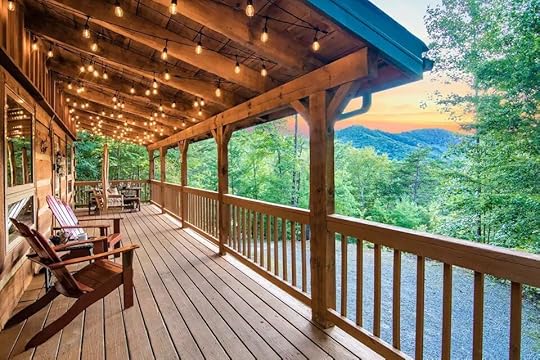
Photo: Airbnb

Photo: Airbnb
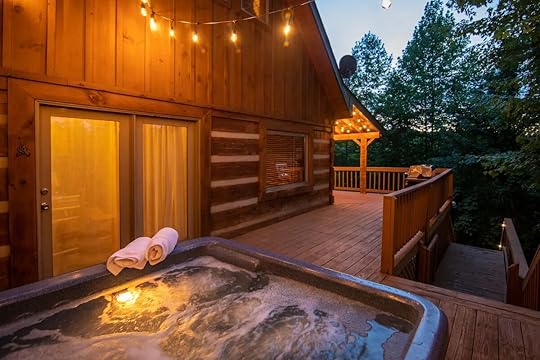
Photo: Airbnb

Photo: Airbnb
This Smoky Mountains Airbnb has everything you need to enjoy a relaxing stay: privacy, a fireplace, a front porch with exceptional views of the mountains and sunset, and an outdoor hot tub surrounded by romantic lights. There’s even a porch swing where you can sip your morning coffee or your digestif while keeping your eyes peeled for a sighting of local wildlife, including bears.

Photo: Airbnb
The cabin can accommodate six guests, so it’s just as practical for a couple wanting a quiet vacation as it is for a small family. Guests have easy access to the gated community’s pool (seasonal), tennis and basketball courts, playground, and frisbee golf area for when they want to step out of this haven of tranquility. While this cabin in the woods is secluded, it’s only an eight-minute drive to Pigeon Forge, a 15-minute drive to Gatlinburg, and a 12-minute drive to Great Smoky Mountains National Park.
Six guests, two bedrooms
Price: $252 per night
2. Rustic cabin only minutes from the Blue Ridge Parkway, Pigeon Forge, Tennessee
Photo: Airbnb

Photo: Airbnb
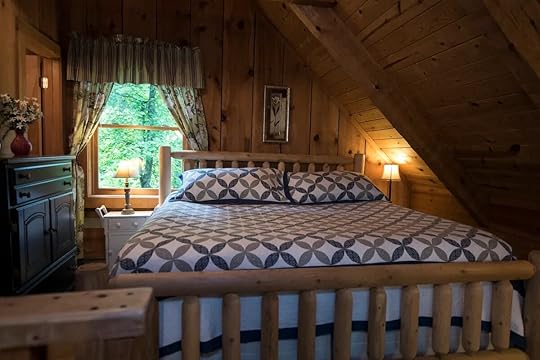
Photo: Airbnb

Photo: Airbnb
This cabin is hidden away in the woods off the scenic Blue Ridge Parkway, so guests have all the privacy and silence they can wish for. To make the most of your stay, sit on the porch swing or one of the rocking chairs and enjoy the rustling of the leaves and the chattering of the wood’s wildlife. Alternatively, you can lounge in the indoor jacuzzi tub while taking in the views from the large windows that surround it.
Inside, the snug and simple wooden decor will help you kick back and relax when you’re not visiting the nearby attractions. Smoky Mountains cabins are typically pretty remote, but this one is only 1.5 miles to the Main Parkway, five miles to Dollywood, 11 miles to Gatlinburg, and 12 miles to the Great Smoky Mountain National Park.
Two guests, one bedroom
Price: $219 per night
3. Red Bear Cabin in Bryson City, North Carolina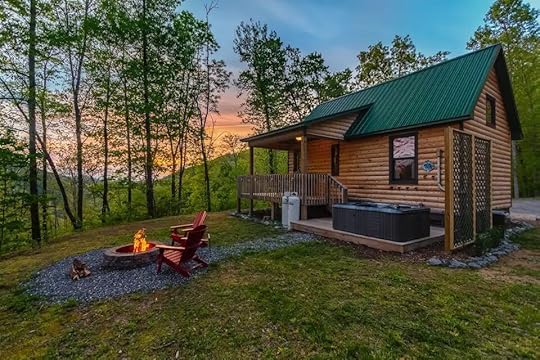
Photo: Airbnb

Photo: Airbnb
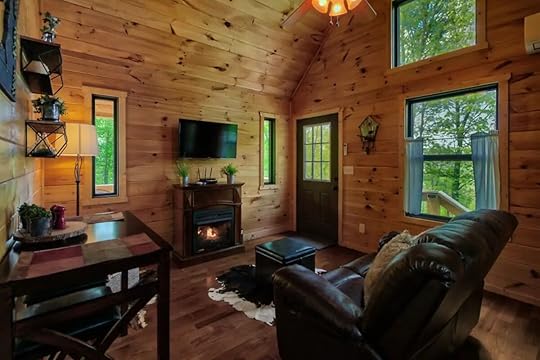
Photo: Airbnb

Photo: Airbnb
The Red Bear Cabin in Bryson City may only be fit for two guests with its one bedroom and one bathroom, but what it lacks in space, it makes up for in comfort and views. Ideal for honeymooners in search of privacy, the cabin has an outdoor hot tub fit for a warm soak under the stars, as well as a covered porch with a swing from where you can admire the vast mountainous landscape.
Inside, the gas fireplace and loft bedroom make things very cozy. There are hiking trails nearby and the cabin is only minutes from the Great Smoky Mountains National Park and 15 minutes from Bryson City.
Two guests, one bedroom
Price: $169 per night
4. Creekside cabin in Cosby, Tennessee
Photo: Airbnb

Photo: Airbnb

Photo: Airbnb

Photo: Airbnb
This one-bedroom cabin in Cosby, TN, at the base of the Smoky Mountains, is as cute from the outside as it is from the inside. With custom woodwork throughout (most of which made from salvaged materials), from the interior barn doors to the beds and kitchen table, this cabin has a rustic feel but is filled with modern and stylish amenities. Hosts know how to transport guests to the mountains with country-feel soft furnishings, featuring plaid and bear prints — even the shower curtain looks like birch bark for a complete look.
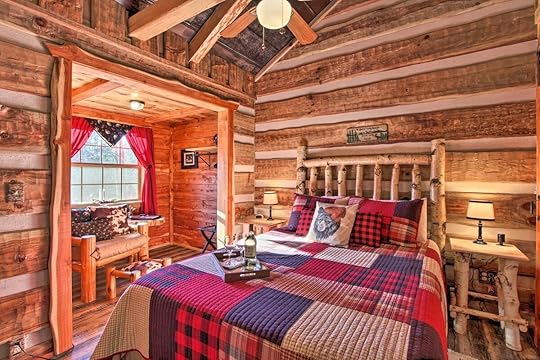
Photo: Airbnb
The covered back deck has an outdoor hot tub with views on Caney Creek for a private spa session in nature. If you’re discreet enough, you might even be treated to the sight of a deer or bear strolling nearby. The cabin is located 30-40-minutes from Gatlinburg and Pigeon Forge.
Two guests, one bedroom
Price: $99 per night
5. Modern Three Oaks Retreat cabin in Gatlinburg, Tennesse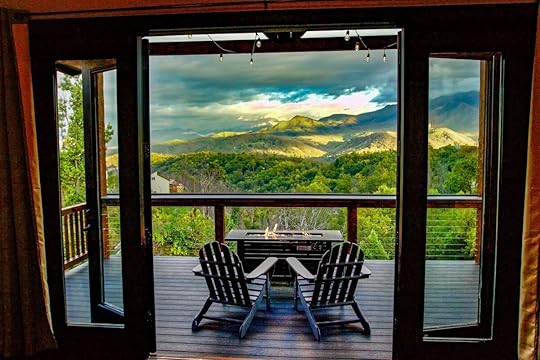
Photo: Airbnb
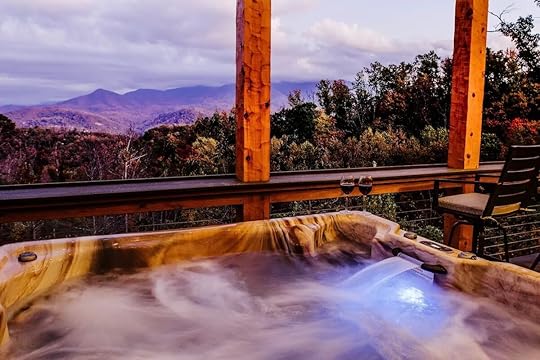
Photo: Airbnb

Photo: Airbnb

Photo: Airbnb
The Three Oaks Retreat is a modern and luxurious cabin that can accommodate up to six guests. Because it was completed in January 2020, everything in the cabin is brand new and spotless, but that does not take away from its charm. With wood throughout, from floor to ceiling, the mountain vibe won’t pass you by. The tall ceilings and the mezzanine provide the spacious living space needed for large families or groups.
Its views are impeccable — the place is basically a mansion on the mountain, and one of the nicest vacation rentals in Gatlinburg (check out Matador’s guide to Gatlinburb Airbnbs).
Six guests, three bedrooms
Price: $565 per night
6. Creekside, multi-deck cabin in Sevierville, TN
Photo: Airbnb

Photo: Airbnb

Photo: Airbnb

Photo: Airbnb
Secluded in the woods, this cabin is the perfect spot for indoor-outdoor living. The several decks offer tranquil views of the forest and the creek below for guests to enjoy breakfast, coffee breaks, aperitifs, supper, and more to the sound of birds. The covered hot tub by the stair is a great way to feel as one with nature while staying warm and comfortable, while the walkway and bridge make a lovely morning stroll.
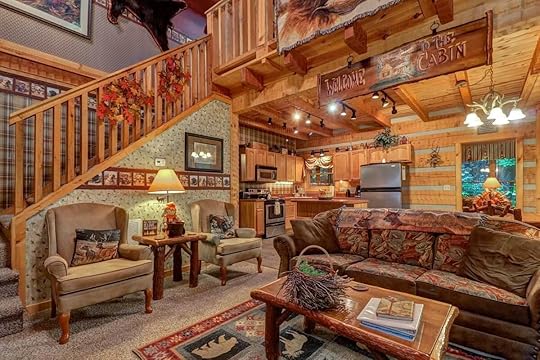
Photo: Airbnb
Inside, the decor is rustic, and the layout is family-gathering friendly with a large dining table, a spacious kitchen, a pool table, and a good-size sunroom. Of all Smoky Mountains cabins, this one makes you feel the most like you’re in the wild west (albeit infused with modern luxury.)
Six guests, two bedrooms
Price: $282 per night
7. Secluded cabin with 650 feet of covered deck in Bryson City, North Carolina
Photo: Airbnb

Photo: Airbnb
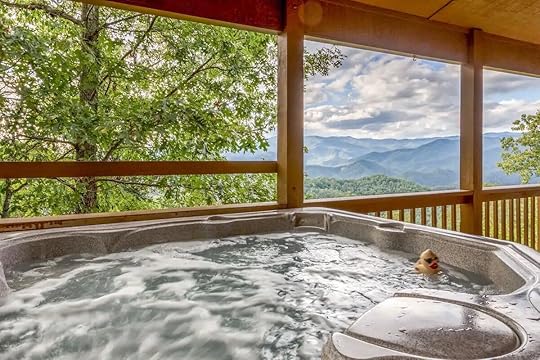
Photo: Airbnb

Photo: Airbnb
Those who want to vacation in the Great Smoky Mountains do it to spend time in nature and enjoy the beauty of the mountains. With this cabin nicknamed “Heaven on Earth” located on five acres of remote land and featuring 650 square feet of deck, you’ll do just that. The panoramic views from the house are breathtaking and you won’t hear a peep from other human beings as the cabin is surrounded by mountains only.
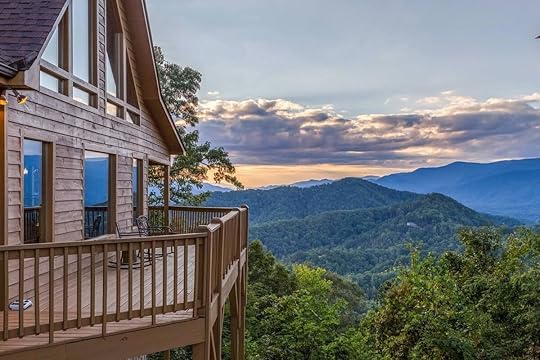
Photo: Airbnb
To spend even more time outside, there’s an outdoor fire pit and a hot tub on the deck. If you’d rather stay inside, the woodstove will keep you warm. This unique cabin can accommodate six guests. 
A version of this article was previously published on December 4, 2020, and was updated on April 11, 2022, with more information.
More like thisWhere to StayThe Best Airbnbs in Asheville, From an Urban Treehouse To a Coffee Shop LoftLooking for Your Next Favorite Road Trip? You Need To Take a Scenic Byway

In both popular culture and our imaginations, we tend to romanticize road trips as epic journeys across the nation’s vast highways. The only problem is, there’s nothing romantic about our nation’s highways. Either you’re sitting in bumper-to-bumper traffic as you pass through a major metropolis, or you’re the lone motorist on an eerily empty stretch of cornfield-lined pavement. We almost take for granted that the great American road trip should be on a highway – but we’re forgetting about a far more attractive alternative: scenic byways.
National Scenic Byways are officially designated roads that meet a set of government-defined criteria. To become a scenic byway, a road must be recognized for one or more of six “intrinsic qualities,” which include archaeological, cultural, natural, historic, recreational, or scenic significance. As their name suggests, these roads are the most scenic way to see the country by far. Here’s why your next road trip should be on a scenic byway.
The difference between a byway and a highway
Photo: ehrlif/Shutterstock
On the surface, distinguishing a highway from a scenic byway might sound complicated. The differences, however, are actually quite obvious, especially when you first make the switch from highways to byways. Highways are wide roads connecting big cities, built to facilitate the flow of heavy traffic. Though they can be found all over the country, they’re a staple of major metropolitan areas with high population density. Though highways are certainly the most efficient way to travel, they’re often not free, with many requiring tolls to pass.
Byways, by contrast, tend to be narrower, secondary roads often located in rural areas. You won’t find scenic byways wrapping around major cities, but rather serve as a means of connection for those living in less populated areas. They’re unstructured, unsurfaced, or even covered with grass.
The National Scenic Byways Program started in 1991, when Congress passed the Intermodal Surface Transportation Efficiency Act, which aimed to promote roads of special aesthetic or cultural significance. Some byways are even designated All-American Roads, which must meet two (instead of just one) of the “intrinsic qualities” mentioned above. All-American Roads are considered to have unique features that can’t be found anywhere else in the US. Many even consider these roads to be destinations on their own.
Why ride a byway?If you still find yourself tempted by the efficient allure of the highway, there are plenty of reasons to give scenic byways a shot the next time you hit the road. The biggest benefit of scenic byways is, by far, the access they provide to local experiences like food, history, and scenery. From New Jersey to California and everywhere in between, highways feel pretty homogenous. Byways don’t circumvent an area’s natural beauty in favor of efficiency – they take you through the heart of forests, mountains, and small towns, giving you a reason to actually look out the window.
The Blue Ridge Parkway in North Carolina and Virginia, for example, gives drivers incredible views of the surrounding mountains and valleys, and Rangeley Lakes National Scenic Byway in Maine gives you a sampling of Maine’s natural beauty: lakes, forests, farms, rivers, and wildlife. Meanwhile, the Mohawk Trail Byway in Williamstown, Massachusetts marks where Benedict Arnold led an army during the Revolutionary War, and where the Mohawk tribe battled the Pocumtucks. That’s a slice of culture you just can’t get on a highway.
Byways are also beneficial for local communities. Rather than spending your money at the McDonald’s in the highway rest stop, you’ll be passing through small towns. That means local shops, restaurants, and a warmer introduction to an area than you’d ever receive at a highway visitor center. Trade the highway McDouble for some steak tips at a local barbeque joint. Rather than stretch your legs at a nondescript rest stop, park on a town’s Main Street and go exploring. A more intimate travel experience isn’t just beneficial for you, but for the people living there too. Whether it’s patronizing family-owned restaurants, shopping at small boutiques, or even filling up at an off-the-beaten-path gas station, the local economy will thank you.
Explore the new byways
Photo: Jacon Boomsma/Shutterstock

Photo: Michael Shake/Shutterstock

Photo: Terry Kelly/Shutterstock

Photo: PTZ Pictures/Shutterstock
Now is actually the best time to start exploring the country’s scenic byways. 2021 was the first year since 2009 that new routes have been added, and they include 34 National Scenic Byways and 15 All-American Roads across 28 states. These are a few new byways you should keep on your radar for your next road trip.
Wisconsin Lake Superior Scenic Byway, WisconsinThis 70-mile road hugs the southern shore of Lake Superior, offering fittingly “superior” views of the lake along the Bayfield Peninsula. In addition to the lake, you’ll also be able to see waterfalls at Houghton Falls State Natural Area, the Onion and Sioux rivers, and a coastal estuary at Frog Bay Tribal National Park.
Hocking Hills Scenic Byway, OhioThis byway is perfect for those seeking a dose of Native American history. The road connects several Native American sites within Hocking Hills State Park, including a mount built by the Hopewell tribe, and Ash Cave – a cave filled with artifacts and old animal bones. You’ll also see hominy holes, which were used as ovens.
Scenic Highway 30A, FloridaThis 24-mile, two-lane byway travels parallel to the Gulf of Mexico, and it might be the best way to get a sense of coastal life along the Florida Panhandle. You won’t find any major cities on this road, just small towns abutting the beach. There are also state parks to be visited along the way, like Topsail Hill Preserve State Park, which is known for its sand dunes.
Pine Barrens Byway, New JerseyCutting right through the Pinelands National Reserve, a UNESCO biosphere, this byway is the best way to see one of New Jersey’s most unique landscapes. The Pine Barrens, defined by its pygmy pine forest and carnivorous plants, is home to 40 different mammal species, 300 bird species, and 60 reptile and amphibian species.
The world's 15 most expensive hotels

There’s shoestring travel, then there’s budget travel, then there’s travel, then business travel, and then elite travel. Way, way, way up — way higher than any of those — is megarich travel. It’s the type of travel that only happens on a private jet, with chauffeurs to the most expensive hotel in the world. It’s “I have a pet tiger and I could easily get away with feeding someone to it” travel.
Naturally, this level of travel requires a certain type of accommodation. There are no hostels, no shared bathrooms, no trips to the ice machine at this level of accommodation. This is Wolf of Wall Street lodging. This is “I need a place to spend the night while my manservant replenishes my yacht’s cocaine vaults” lodging.
You get the idea. These are the most expensive hotels in the world. Here’s what spending more than the majority of the world’s annual income is on a single night in a hotel room looks like.
We hope you love the spaces and stays we recommend! Just so you know, Matador may collect a small commission from the links on this page if you decide to book a stay. Listed prices are accurate as of the time of publication. See our full Advertiser Disclosure here.
1. The Apartment at the Hotel Connaught in London

Photo: The Connaught/Facebook
At $23,500 a night, the Apartment offers a private butler and menus designed by Michelin-starred chef Helene Darroze. It has a wrap-around balcony overlooking London’s incredibly posh Mayfair area.
To get a good idea of just how over-the-top British blueblood opulent this place is, check out their interactive site regarding the Apartment — it includes stories of the butler flying to Paris after guests left to return the shoes they’d forgotten and a guy who wanted to cook his wife a meal and had a Michelin chef passing him tips behind a secret door. I mean, Christ.
2. The Presidential Suite at the Hotel Cala di Volpe in Porto Cervo, Italy

Photo: Hotel Cala di Volpe/Facebook
At $26,000 a night, the Presidential Suite at the Hotel Cala di Volpe in Sardinia offers three bedrooms, a solarium, a private pool, and a fitness area. Each of the three bathrooms has a jacuzzi, an “oversized shower,” and “dual vanities of Sardinian marble.”
3. The Shangri-La Suite at the Shangri-La Bosphorus in Istanbul

Photo: Shangri-La Bosphorus Istanbul/Facebook
At a mere $26,385 a night, the Shangri-La Suite takes up the entire top floor of the Shangri-La hotel, overlooking the Bosphorus Strait in Istanbul. There’s a TV embedded in that bathroom mirror, by the way. The room has three private terraces that give you views of pretty much the entire Istanbul skyline.
4. The Presidential Suite at the Mandarin Oriental in Shanghai

Photo: Mandarin Oriental Pudong Shanghai/Facebook
Located in spectacular, skyscraper-heavy Pudong, the best suite at the Mandarin Oriental is about $26,450 a night. It’s a two-bedroom apartment with its own wine cellar and staggering 25th-floor views of the Shanghai skyline. It, of course, has butler service, and they promise flexible check-in and check-out, saying you can enjoy your full 24 hours in the hotel. I should hope so!
5. The Royal Suite at the Hôtel Plaza Athénée in Paris

Photo: Hotel Plaza Athenee/Facebook
The Royal Suite at this hotel is the largest hotel room in Paris, with 450 square meters. It’s also $27,000 a night…$27,000 which totally could have gone towards paying off my student loans instead. The suite includes televisions concealed behind the mirrors, and “all the embroidery is done with gold thread.” In large part, what you’re paying for in this suite is proximity to gold.
6. The villa at the JW Marriott Mauritius Resort

Photo: JW Marriott Mauritius Resort/Facebook
The villa at JW Marriott Mauritius Resort is the largest villa on the island and costs $30,000 a night. It includes a Jacuzzi, a lounge, a bar, and a private chef. The best amenity listed on the site by far, though, is that they specialize in “discreetly addressing guests’ needs.”
7. The Royal Suite at St. Regis Saadiyat Island, in the United Arab Emirates

Photo: The St. Regis Saadiyat Island Abu Dhabi/Facebook
At $35,000 a night, the Royal Suite at St. Regis is the largest hotel room in the UAE. It has two floors, butler service, and a private theater. It also has a swimming pool and a games room. The master bedroom takes up pretty much all of the bottom floor and looks out over the ocean.
8. The Royal Villa at the Grand Resort Lagonissi in Athens

Photo: Grand Resort Lagonissi/Facebook
The Royal Villa, at $35,000 a night, once played host to Mel Gibson and Leonardo DiCaprio. It has two master bedrooms, each with marble bathrooms with their own steam baths, as well as the butler’s quarters. There’s also a private massage area, a heated pool, and a private deck overlooking the beach.
9. The Penthouse Suite at the Grand Hyatt Cannes Hôtel Martinez

Photo: Hotel Martinez in the Unbound Collection by Hyatt/Facebook
At a quaint $37,500 a night, the Penthouse Suite at the Hotel Martinez in Cannes offers views of the Bay of Cannes (from a terrace Jacuzzi, of course), and two king-size bedrooms. Strangely, compared to the other suites on this list, the Grand Hyatt’s amenities list, rather than using the words “opulence,” “luxury,” and, “gold-leaf covered heated toilet seat,” lists things like “wireless internet,” “a bathrobe,” and “Windows that open.” Don’t let that understated description fool you, though — according to Billionaire.com it is the fourth most expensive hotel room in the world.
10. The Hilltop Estate Owner’s Accommodation at the Laucala Island Resort in Fiji

Photo: Laucala Island/Facebook
Not only is this villa $40,000 a night, but you can’t just book the room. You have to apply for the privilege of giving them enough money to pay the equivalent of most four-year in-state college tuitions over the course of a day.
The entire island is owned by Red Bull’s billionaire owner and consists of 25 villas, but this is the best. It has panoramic views of the island, free massages, horse rides on the beach, and I imagine it allows you to hunt the deadliest game of all: man.
The webpage — which uses the word “opulent” like it’s a good thing — also says it provides a private cook, a chauffeur, and a private nanny. It will, and I quote, make your “undreamt of pleasures come true.” Which sounds like an underestimation of the weird pleasures people dream about.
11. The Ty Warner Penthouse at the Four Seasons in New York

Photo: Used with permission of Four Seasons
The Ty Warner Suite at the Four Seasons in New York will set you back a cool $45,000 a night. It’s the highest hotel room in New York, with a 360 view of the city, and it took seven years and $50 million dollars to build. The room has its own art concierge and also a huge library. It only houses three — with accommodations for a child (and let’s be honest, the only child that will ever stay here is Prince George).
Here’s their website’s pathologically detailed description of the bathroom: “The master bathroom is entirely clad in custom slabs of rare Chinese onyx and includes sinks carved from solid blocks of rock crystal, underlit with LED lighting. Unwind in a chromatherapy infinity soak tub or an oversized Dornbracht steam rain shower with six body jets. Other features include a Toto Neorest toilet with wireless remote, sensors and heated seat, and floors with radiant heat. The walls, ceiling and sink in the jewel-like guest powder room are fashioned from semi-precious tiger’s eye stone.”
12. The Sky Villa at the Palms Resort in Las Vegas

Photo: Palms Casino Resort/Facebook
At $40,000 a night, the Sky Villa offers a private glass elevator, a glass spa jutting out over the balcony with views of the strip, a dry sauna, and 24-hour butler service. There are actually a few Sky Villas, but the most luxurious one is called the Hugh Hefner Sky Villa. Because it’s Vegas, so of course.
13. Burj Al Arab in Dubai

Photo: Creative Family/Shutterstock
No catalog of the gaudily expensive would be complete without a mention of Dubai. While many of our other hotels on this list get a spot by merely having an absurdly expensive and luxurious suite, the Burj Al Arab gets on for having nothing but absurdly expensive luxury suites.
All of their suites are duplexes, and the cheapest of them is $2,000 a night. Not including taxes and fees. The most expensive is around $12,000. This may well be — overall — the most expensive hotel in the world.
The amenities? You can get around in their Rolls-Royce, Mercedes, and helicopter transfer services. Or take advantage of their personalized butlers. Also, you can go to their four swimming pools and private beach, or get free access to a nearby waterpark. It’s a great place to go to show your complete contempt for the concept of moderation.
14. The Shahi Mahal Suite at the Raj Palace Hotel in Jaipur, India

Photo: The Raj Palace/Facebook
This suite at the Raj Palace Hotel costs $45,000. For a night. It’s got six bedrooms, a private theater, a library, and private kitchen staff, but again: It’s 45 grand a night. It’s a particularly good fit if you’re a Bond villain, royalty, or need a nice place to get together with some friends for a trip of a lifetime in India.
15. The Royal Penthouse Suite at the Hotel President Wilson in Geneva, Switzerland

Photo: Hotel President Wilson/Facebook
At 60,000 Swiss Francs a night — or about $68,000 — this is the most expensive hotel room in the world. The suite has hosted the likes of Bill Gates and Michael Douglas and includes its own private elevator, gym, and pool table; it has maximum security, a Steinway Grand Piano, and a panoramic view of Lake Geneva.
The good news is that it sleeps up to six people (it has 12 bedrooms and bathrooms, but the site says it only sleeps six). So you can split the price with your other comically rich friends. 
A version of this article was previously published on May 10, 2014, and was updated on April 11, 2022.
More like thisWhere to Stay9 of the Best Adults-Only All-Inclusive Resorts in the CaribbeanApril 9, 2022
Delta Is Grouping Seats so Families Can Easily Sit Together Now

It’s not uncommon to find the perfect flight for the right price only for there to be no way for you to sit with your family members. This can mean a game of airplane musical chairs before takeoff just so families can stay together. Delta Air Lines is remedying this with a new group seating plan.
Delta has been blocking off rows near the back of the plane to make them only available to passengers flying in groups of three or more, according to The Points Guy. However, the rows are also available for Medallion elite members who only have one or two passengers on the reservation. The carrier has been doing so quietly since 2019 to try and figure out an algorithm for how many rows should be saved depending on the route. A route to a family destination like Orlando may have more seats blocked off than, say, a business trip route between Chicago and Boston.
To see which seats are blocked, head to seat selection for booking. If you look towards the back of the plane and see rows of three that are not available for booking near the back of the aircraft that are blocked off but not occupied, those seats are probably reserved for family or group seating.
Delta is the first airline to try group seating, so who knows? Maybe more airlines will see that the family that buys tickets together should stay together. 
The World’s First Airport Cannabis Dispensary Plans To Open This Summer

Canadians will soon be able to easily fly high right before or shortly after coming down from 30,000 feet.
At a press conference in January, Prince George Airport Authority (PGAA) announced that it partnered with Copilot, a dispensary that is “pioneering cannabis for travel.” Since then, the Prince George City Council gave preliminary approval with the support of airport regulators for the first airport dispensary in Canada — and the world — at Prince George Airport Authority.
Canada legalized cannabis in 2018 and Canadian law allows domestic air travelers to have up to 30 grams of flower or the equivalent in other products. To accommodate travelers, many airports have already established areas where the consumption of cannabis is permitted.
“Our goal from day one has been to create a differentiated retail experience that stands out from any store you might see downtown,” Owen Ritz, co-founder of Copilot told the Canadian Press.
Copilot staff will check customers’ boarding passes to ensure that they are booked on a domestic flight. The airport dispensary will not sell cannabis to international travelers or those employed by the airport or airlines. However, two of Canada’s major airlines, Air Canada and WestJet, cited concerns about passengers with international layovers and intoxicated passengers.
“This could be highly problematic,” said Serge Corbeil, Air Canada’s director of local and provincial government relations at a public hearing, according to High Times. “(And) while rare, there are instances where a flight may be domestic, but be diverted into the United States.”
Prince George City Councilor Cori Ramsey disagreed due to the fact that a number of Canadian airports already have cannabis consumption areas and businesses that sell and serve alcohol. Ramsey went so far during the public hearing to say that there could be dispensaries in most Canadian airports in the span of 15 years.
There’s currently no set date for Copilot’s opening, but the company’s website says summer 2022. Maybe the next time you’re province hopping in Canada, you’ll be able to purchase and enjoy a joint or two without leaving the airport. 
April 8, 2022
Guide to Irish slang

There are three languages spoken in Ireland: Irish (Gaeilge), Ullans (in Northern Ireland), and English. But don’t think for a second that, because the people of this lovely island speak English, it will be easy for you to befriend the locals. Irish slang words and phrases are ubiquitous, even in polite conversation, so you’ll need to master them to make heads or tails of what’s being said at the pub.
This guide to Irish slang words and phrases, insults, and expressions will assist you in deciphering some of what the locals are saying while in Ireland. It even includes a guide to reading between the lines of what the Irish are really saying when they address you — read it carefully!
The state of you!
Meaning: You’re a disgrace
Example of usage and translation: “Oh my god, she was an absolute state. Did you see her taking a piss in front of the Garda station?” = “Oh my god, she was a disgrace. Did you see her going to the toilet in front of the police station?”
Meaning: I’m alright
Explanation: Often the answer to “How are you?”
Meaning: Party
Explanation: This is a blanket term for any kind of social gathering that has the potential to get a little loose.
Example of usage and translation: “Fair auld session last night there lads, great to get the lock in” = “Great night of merriment and music last night boys, delighted to be able to stay after hours in the pub”
Meaning: He’s cool
ShiftMeaning: Kissing with the tongue
Examples of usage and translation: “Here, will ye shift me mate?” = “Hey, will you kiss my friend?” / “Yer man’s a great shift” = “That guy’s a really good kisser”
Meaning: How are you? / What’s new?
Yer man / Yer oneMeaning: That guy / that girl
Example of usage and translation: “You know yer man, the ginger fella who’s friends with Cathal” = “You know, that ginger guy who’s friends with Cathal”
Meaning: I’m drunk
Note: “Gee” is also a slang term for vagina
Meaning: Good looking person / sex
Examples of usage and translation: “Did ye get the ride off yer one last?” = “Did you have sex with that girl last night?” / “OMG, Brian O’Driscoll is suuuuuuuuuuuuch a ride” = “Brian O’Driscoll is hot”
Meaning: Oh my God!
Explanation: In Ireland, it’s okay to use the Lord’s name in vain to express your frustration.
Meaning: I’m mad / very annoyed
Good man yourself / Good woman yourself!Meaning: Well done!
Example of usage and translation: “Jaysus, you did well there, good woman yourself!” = “Jesus man, well done, congratulations!”
Meaning: Hurry up!
YokeMeaning: Thingy
Example of usage and translation: “Where’s that yoke gone?” = “Where has that random thing gone that I was looking for?”
Meaning: I told him off / I scolded him
Me mot / Me motzerMeaning: My girlfriend
Note: You can also refer to a group of females as ‘mots.’
Meaning: Very
Example of usage and translation: “It’s fierce windy out” = “It’s very windy outside”
Meaning: Equivalent the F word
Example of usage and translation: “where’s me bleedin phone?” = “Where my F****** phone?”
Meaning: That sucks / How unfortunate for you
CulchieMeaning: A person from the country, or basically anyone that comes from anywhere other than Dublin.
JackeenMeaning: What culchies call people from Dublin.
A Gaff partyMeaning: A house party
The JacksMeaning: The bathroom
The DrinklinkMeaning: An ATM during a night out
You’re the image of massiveMeaning: You look great
I’m going on the lashMeaning: I’m going to get drunk
He’s giving it socksMeaning: He’s really going for it
Example of usage and translation: “Yer man was giving it socks on the dance floor last night” = “That guy was dancing non-stop last night”
Meaning: I will not
PoxyMeaning: Bad or terrible
Example of usage and translation: “You’re a poxy bleedin liar” = “You’re a terrible F****** liar”
Meaning: How embarrassing for you.
Note: The complete version of this slang phrase is “scarlet for your ma for having ya” which translates as “You did something extremely embarrassing and should be disowned.”
Quit yer gurning
Meaning: Stop moaning / complaining
Note: ‘To gurn’ is to complain about a person.
Meaning: Be quiet
I’ll run ye overMeaning: This is not a threat, but a person offering a lift to another person.
She’s up to high dohMeaning: She’s overly excited
Example of usage and translation: “She’s seen Jamie Dornan walking around Belfast and now she up to high doh.”
Meaning: It’s damaged beyond repair
I’m founderedMeaning: I’m cold
A tonginMeaning: A scolding
Example of usage and translation: He spent the whole evening drinking at the pub. He’s going home to a tongin from the wife.
She’s a geebag
Meaning: She is very annoying
Explanation: An insult that translates literally as ‘a bag of vaginas.’
Meaning: He is an idiot
He’s an eejitMeaning: He is an idiot
Explanation: The proper way to pronounce ‘idiot’ in Ireland.
Note: In Nothern Ireland, you’ll hear the insult ‘Buck eejit’, which means just about the same thing.
Meaning: Little brats /little shits
Explanation: shitehawk can be used affectionately.
Meaning: She’s a mad b*tch
She’s pure hauntyMeaning: she’s an unfortunate looking girl wearing a lot of make-up to try and cover it up.
He can talk the hind legs off a donkey
Meaning: He is very chatty / He can talk at length
Example of usage and translation: “God yer one would talk the hind legs off a donkey” = “That girl would bore you to death with her incessant talk”
Meaning: To kiss someone passionately
Example of usage and translation: “My mouth is red raw, he was scoring the face off me for hours at Coppers” = “I have sandpapered my skin off my passionately kissing someone for hours in the local meat market”
Meaning: Stop acting up
Note: Most often said by one’s mother, it basically means stop doing what you’re doing right now, or suffer the consequences.
Meaning: A mess
Example of usage and translation: “Me hair’s all over the shop” = “My hair is a mess”
Meaning: He’s dead
She’s away with the fairiesMeaning: She’s little bit mad
You could skin a cat out thereMeaning: It’s very cold outside
If you’re ever in Ireland, give me a shout!
Note: A lie. We actually do not want a casual acquaintance arriving on our doorstep expecting to be put up and shown the town.
Sure we’ll just go for one pintTranslation: I’m not planning on getting absolutely hammered, but one might very well turn into 15.
Ah, it’s just up the roadNote: This could mean anything. From a few houses to several miles away.
Sure the rain will stop in five minutesNote: A show of optimism that relies on nothing but hope. Nobody knows when the rain will stop in Ireland.
Ah shite, I never got round to itTranslation: I will never get around to it. Ever. I can’t be arsed.
I’ll do it now in a minuteTranslation: I will never do it
I will yeahTranslation: I won’t
Thanks a million = Thank you very muchchipper = Local greasy food stand where you can get French friesBacon = RasherSliced bread = Sliced panThe messages = GroceriesThe press = The cupboardMinerals = Soft / fizzy drinksDilutable = Non-alcoholic concentrated syrup used to make beverages. It’s often called ‘squash’ or ‘cordial’ in other countries. Ribena is a blackcurrant dilutable very popular in Ireland.Courtin = Dating (term commonly used in Northern Ireland)

This article is the combined work of four writers: Sorcha O’Higgins, Tara Povey, Sarah Arnold, and Niall Colbert.
More like thisLanguages8 Irish Gaelic Sayings About Guinness, Tea, and God That’ll Help You Understand Irish CultureLearn Astrophotography and Capture Colorado’s Night Sky on This Incredible Airbnb Experience

Photography allows people can capture the best moments of their lives. There are many different types and forms of photography that anyone can get into, none more interesting to the naked eye than astrophotography. Astrophotography is photography involving astronomical objects — stars, planets, and the rest of the cosmos — and events or areas involving the nighttime sky. Experience and take astrophotography to a new level with an epic Colorado astrophotography experience.
This Colorado astrophotography experience is the perfect place to start, whether you’re a beginner or someone who wants to get back into the astrophotography field. The company Colorado Astrophotography takes guests and connects them on another level with nature that they have never explored before. This Colorado astrophotography experience teaches guests the ins and outs of shooting and how to take optimal astrophotography shots.
The company Colorado Astrophotography is not only educating those on astrophotography but creating new astrophotographers, a one-of-a-kind experience, and having one left with incredible photographs and memories to look back on. The company spoke with Matador about the astonishing experience and how to begin if you’re thinking about it.
We hope you love the astrophotography experience with Colorado Astrophotography! Just so you know, Matador may collect a small commission from the links on this page if you decide to book a stay. Listed prices are accurate as of the time of publication. See our full Advertiser Disclosure here.
Want to know more about the night sky and how you can capture amazing photos of it? Then check out this Colorado astrophotography experience on Airbnb.
Traveling to Colorado? Check out Matador’s Colorado accommodation guides to the best places to stay across the state: 10 Airbnb Estes Park rentals near Rocky Mountain National ParkThese Denver airport hotels put you close to the terminal with luxe amenitiesThe best Airbnbs in Denver for beer, 420, and mountain cultureVail Airbnbs that make you feel like you’re in the heart of BavariaAspen Airbnbs to chill like a celebrityStay near Garden of the Gods and Pikes Peak at these Colorado Springs Airbnbs
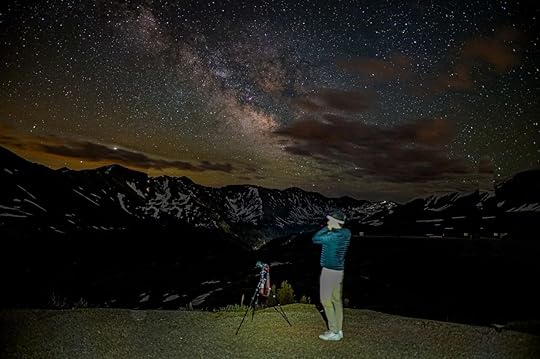
Photo: Airbnb

Photo: Airbnb

Photo: Airbnb
This interview has been edited for length and clarity.
Matador: When did you begin astrophotography, and how did this experience start?Colorado Astrophotography: Photography I began over 20 years ago, but it wasn’t until about five years ago that I mastered astrophotography and completely fell in love. This experience started about four years ago. I have some Airbnb properties, so when they opened up experiences in the Denver area, As years rolled by and the pandemic hit, I turned 40 and decided to go for it full time. That’s when it was no longer just an Airbnb experience but became my business, Colorado Astrophotography, and now we partner with various booking platforms and have our own.
Matador: When is the best time for astrophotography in Colorado?All the seasons have different advantages, but my favorite time of year is in the late summer or early fall. The milky way is visible right after sunset, so the nights aren’t so late (or cold). The winter has more meteor activity, and a different crispness to images since the camera sensor can stay cooler.
Matador: Where do you go for this experience, and why is that an ideal spot for the experience?We are permitted to operate in Roosevelt and Arapahoe National Forests. We are working on extending our permitted areas. National forests are ideal spots because they are public land, and you can be there at night. It’s crucial to ensure you are not doing astrophotography on someone’s private property.
Matador:What all takes place during the experience?Lots of fun! We do a three-stop mountain vista tour. We set up and go over settings, and then while guests are taking pictures, the hosts fill them with photography and astronomy knowledge. We use apps to find specific constellations and planets and tell stories about the stars. We also have a killer collaborative playlist and request each guest add a song that has to do with space, the stars, or the moon, so they contribute to the diversity of the experience.
Matador: Do the guests need to bring their gear for this experience?They can, but we also provide all equipment. Some folks even use their own equipment versus ours so they can compare. We are open to helping folks use their own, or if they don’t want to travel with all their gear, they can use ours.
Matador: What advice would you give someone who wants to start astrophotography?Every astrophotographer is a work in progress. Be patient, and don’t be afraid to try new things with light. There is a myth about astrophotography that it has to be completely dark to take a good astro picture, and this is true for deep images of the milky way; however, the moon is beautiful, as is the night sky along with the light the moon provides can be just as captivating, curious, and beautiful.
Matador: What is the process of astrophotography?Astrophotography is a process of preparation.
Step 1: Knowing where you are allowed to go and that the area is safe at night is the first and most crucial step. Always scout your location during the day, so you are familiar with the area at night.
Step 2: Make sure you have all necessary equipment, including a DSLR camera, a lens with a 2.8 or less aperture, a tripod, and a headlamp.
Step 3: Set up equipment, align your composition and focus, and adjust your camera setting according to what you are trying to capture (moon vs. nightscape vs. milky way). Commonly adjusted settings include the shutter speed, aperture, and ISO. Most photographers use the camera RAW file setting so they can manipulate the data of the image better in post-processing. Take the picture and modify settings as needed. Long exposures for the night sky are usually between 20-30 seconds, depending on the size of your lens, so you have plenty of time to be mindful and enjoy the beauty of the moment (which is the best part). We always recommend taking the same photo in various settings so you will have choices of what you like best when you get home.
Step 4: After you have captured your pictures, you can use Lightroom or Photoshop to edit your images and bring out some of the textures, colors, and clarity of your image. Then you enjoy your amazing work!
Matador: Does one need to have photography experience or skills to begin astrophotography?Not at all. We teach people all the time who only have experience with their iPhone, and they walk away with professional quality photographs and a skill that will follow them for the rest of their life.
Matador: Does one need to modify their camera for astrophotography?Not for basic astrophotography. Once you get into more advanced astrophotography, that’s where you can begin using star trackers and telescopes, as well as more complex software that will stack your images. But for basic single-shot astrophotography, most regular DSLR camera setups will suffice as long as the aperture to the lens is 2.8 or less.
Matador: What’s the most unique/surprising thing that’s happened during the experience? (Any amazing, strange, memorable experiences/stories during this tour)My favorite story involves a very serious, kind gentleman telling me all about when he had dinner with world leaders and extraterrestrials. He was pretty detailed in his description, and I kept waiting for him to say he was kidding or pulling my leg. After the experience ended and he left a review, I noticed his profile, and he forgot to mention he was a NASA engineer! 
Matador Network's Blog
- Matador Network's profile
- 6 followers



